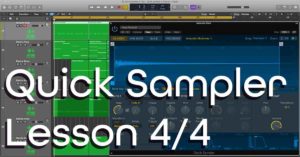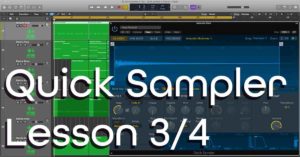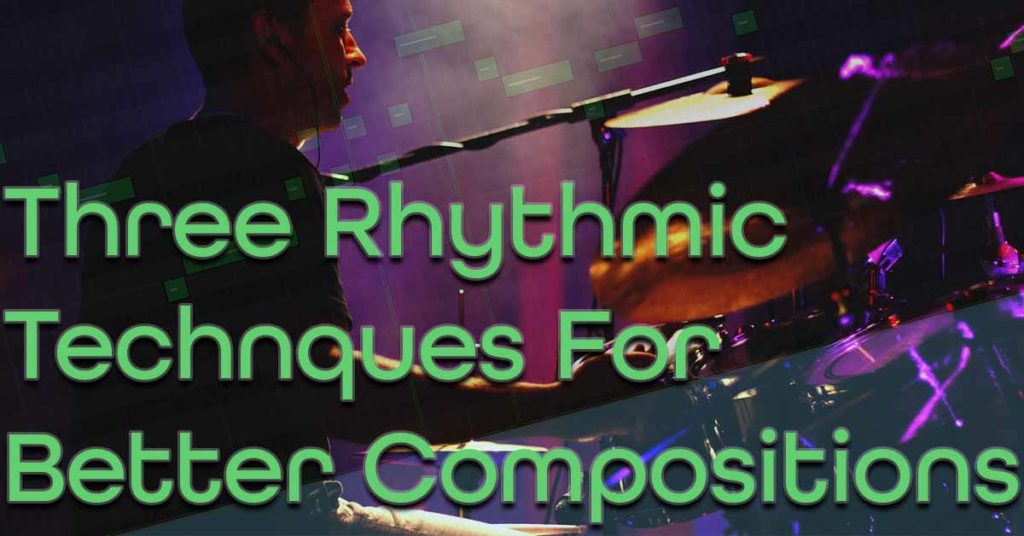
bemusiDarren
Three Rhythmic Techniques For Better Compositions
Add some Extra rhythm
Have you ever found yourself in a musical, rhythmical rut? You’ve found a great rhythm started to loop it round but soon tire of its repetitive nature, that once loved rhythm soon feels dull and boring. What do you do? Scrap it? Add more random layers in the hope that it will improve? Add some pre-made loops?
Why not try out these three simple rhythmical techniques that can help change the direction, develop or even improve the feel of both percussion and melody. Breath new life into your parts by truncating, expanding and displacing them with these three easy top tips.
Truncate your way to better music
When you create a melody or rhythmical part you may want to find ways to develop or alter the rhythm without changing the basic idea. Truncating is to cut short the part, akin to stopping a sentence…….
mid flow!
Or even coming to a conclusion slightly earlier than the first time the rhythm is played.
Take a look at next example and notice how the same two bar rhythm comes to a natural end by being truncated on the down beat of bar four. It’s very simple to do but can be an effective way of creating movement without actually doing anything other than cutting it short. It works well on the strongest beat (beat 1) and the second strongest beat (beat 3), but of course you can do it anywhere you want!

Take a look at the four bars below, notice how the rhythm in bars 3 and 4 is a repetition of bars 1 and 2 but simply cut short. To add a bit more interest and a sense of unexpected silence I’ve slightly changed the ending to finish on a syncopated division; adding subtle rhythmical variation can add even more colour!

Truncation is a great way to change the rhythm without doing anything other than cutting it short, it may seem like an obvious technique but used in clever ways it can create variation and interest. Take a drum rhythm for example and stop it early to add more interest to a part that might well already be quite repetitive.
Expand your compositions
Expanding the rhythm is a way of adding new material to an established pattern, all you have to do is add an extra bar or two varying the pattern and you’re expanding both the rhythm and the music.
Hey Jude by the Beatles does this perfectly at the end of the chorus, an extra bar of 2/4 is added extending the rhythm, it’s so perfectly written that the extra two beats feel as natural as the verse which loops perfectly in groups of 4. So what makes it so natural? At the end of the chorus Paul McCartney sings an ascending line which holds over an extra two counts and then continues the ascending pattern on the piano, which completes the line. All this is done with barely noticing the extra two beats.
Of course it doesn’t have to be simply adding an extra two beats that is largely sustained, as in the Beatles example. The opposite could be true and the expanded rhythm could be whatever you want, perhaps intensifying the rhythm, as in the example below.
Notice it’s the original four bar drum pattern from above with an additional two bars added, which build the tension over bar 5 finally resting with a snare flam on bar 6, beat one. By adding an extra two bars, the rhythm can be expanded and tension can be created. Adding excitement and interest to the music.
These extra two bars can even act as an unexpected surprise for the listener, who may not be expecting the rhythm to be expanded. Remember good song writing is all about balancing the predictable with the unexpected. Expanding your rhythms can be a good way to easily add surprise.
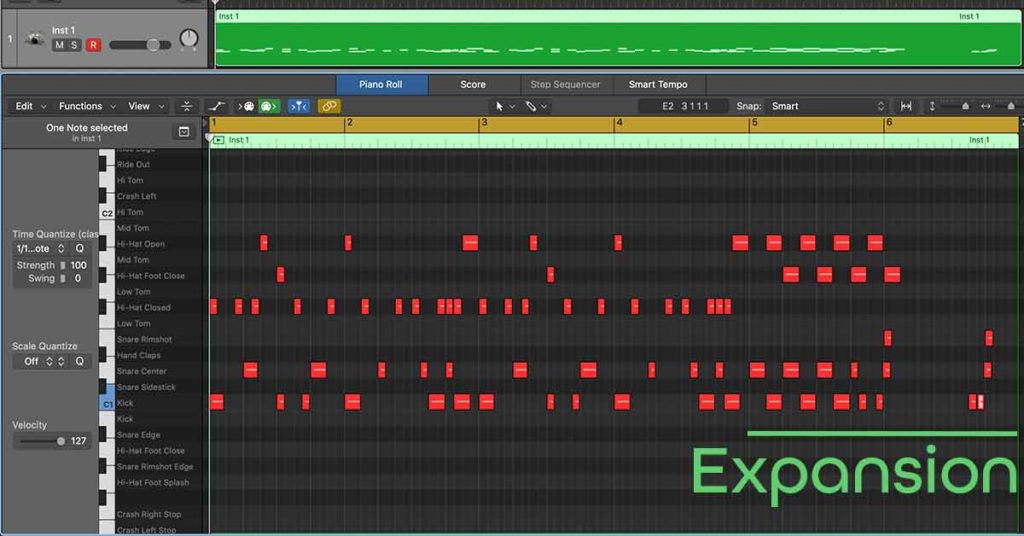
For your own music think about whether truncating or expanding the rhythm could add more interest and excitement to your music. You could try truncating your rhythm on interesting divisions to add more interest or take a small aspect of an existing rhythm and repeat it for an extra bar or two to see if it adds excitement or even contributes to a build up leading to tension and release.
is it in the right place?
Displacing the rhythm is simply taking your existing melody or rhythmical part and starting on a beat or division other than the original. Displacement is a great way to preserve a melody or rhythmical part but create instant variation by simply moving it forward or backwards by an 8th note or 16th or what ever you want!
Take a look at the example below, it is a short two bar phrase that repeats in bars 3 and 4. The difference is the rhythm is displaced by an 8th note. This means the melody starts on the off beat of bar 3. This creates instant variation purely by displacing the rhythm. It’s so simple to do but can be extremely effective in creating interesting variations to the parts you’ve created.
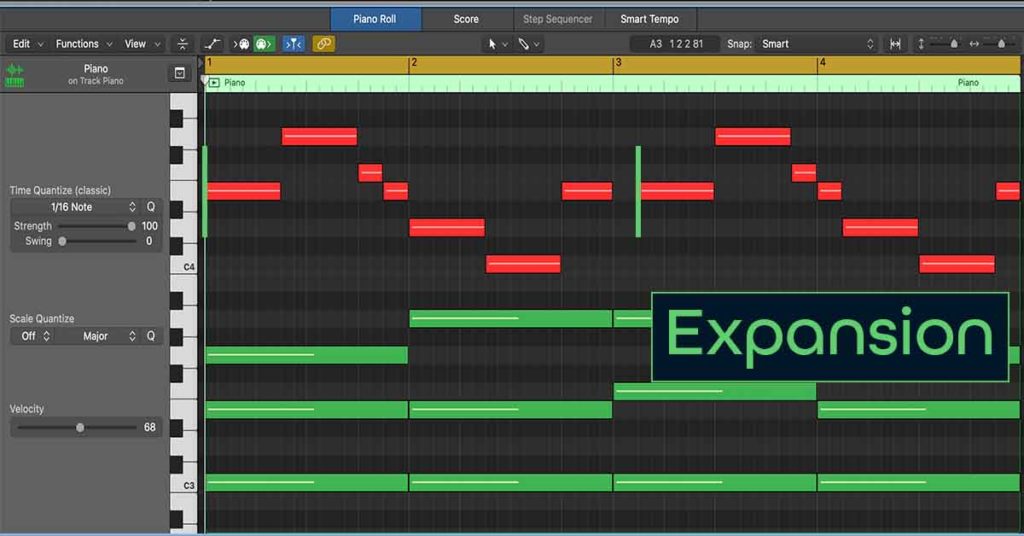
Using Expansion, truncation and displacement in rhythm
You can effectively use either truncation, expansion or displacement in your rhythm parts, whether that’s a programmed drum rhythm or percussion hits supporting a big trailer action cue. In fact for trailer music and big cinematic orchestrations these three simple rhythmical tricks can really add interest and keep your rhythms interesting.
Cinematic cues are often fuelled by layering multiple rhythms from low frequencies to the highs, by using any of the three rhythmical techniques at different points on different layers can add a level of complexity that is very simple to achieve.
When writing drum parts in a rock, hip hop or EDM track, you could use the three techniques to add interest to verses and choruses by adding simple variation expanding rhythms or by truncating them.
Try it out on your rhythm parts and see where your percussion or drums end up.
Using Expansion, truncation and displacement in melody
Although the three techniques discussed are most easily applied to the rhythm section don’t overlook the creative opportunities they can provide to melody and harmony. As already mentioned the Beatles effectively employed expansion in Hey Jude and there are countless other real world examples where the three techniques have been put to good use.
Try writing a four bar melody and experiment with the three techniques.
For example: in the image below bars 1-4 establish the motif, bars 5-8 repeat the motif but truncate the melody on bar 8, bringing it to a natural close. Also notice how the note length at bar 8 has been altered too.

Next try moving your motifs to start on a different division and displace it.
In the example below you can see I have moved the motif an 8th note to the left. This gives a sense that the melody starts to rush as it now comes in early.
Also notice at the end of bat 4 the last note has been muted to make way for the start of the motif repeating. This also creates a nice musical line leading back up to the G (C-D-E-G), by displacing the melody it has created natural movement as the melody starts again.
Finally the truncation has been retained at bar 8 but this time the note is extended in length and remains in the original position, note all notes from the melody have to be displaced.

Finally try extending your motif by adding new material and maybe even incorporating an odd bar number to really get the music going!
To add the final touch in my example (see below) I have extended the motif by adding a bar of 2/4 starting at bar 5. This extends the end of the motif and although you may not use it straight away in a longer piece of music it could work as a clever device to catch the listener off guard or add a bit of unexpected interest later in a piece.
All I have done is extend the notes D-E, which keeps the motif going for an extra beat and a half, the melodic line leading up to the start of the motif is again retained D-E-G and the repetition remains displaced.

Apply them in your writing
Above, I have built up a melody using all three techniques but that doesn’t mean you have to use all three at the same time, of course you can but they are just as effective when used individually. They can be most helpful too when you have a melody that you’re not sure what to do with, applying the three techniques individually or in combination can help you to explore the different possible roots for your melodic ideas and may even end up taking you somewhere magical you weren’t expecting!
Have fun using these simple but effective techniques!
Are you interested in Learning how to compose music?
Subscribe to the be musi mailing list and learn more about music, be musi courses, how to develop your career, musicianship, and production skills.



